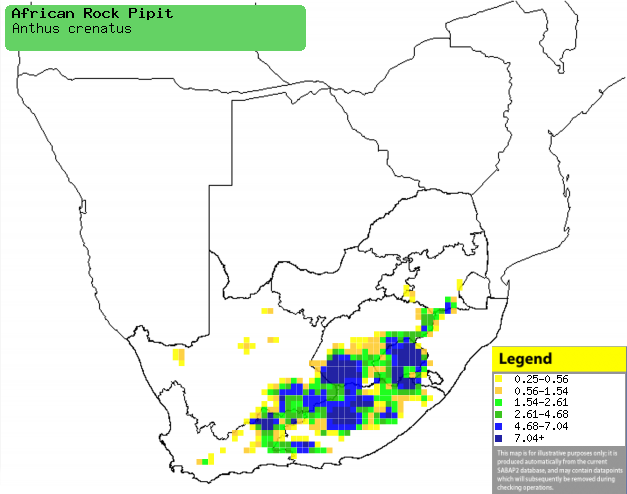|
Anthus crenatus (African rock
pipit, Rock pipit)
Klipkoester [Afrikaans]; Tšase-ea-thaba, Tšase-tatalana
[South Sotho]; Kopjespieper [Dutch]; Pipit des rochers [French];
Klippenpieper [German]; Petinha-das-rochas [Portuguese]
Life
> Eukaryotes >
Opisthokonta
> Metazoa (animals) >
Bilateria >
Deuterostomia > Chordata >
Craniata > Vertebrata (vertebrates) > Gnathostomata (jawed
vertebrates) > Teleostomi (teleost fish) > Osteichthyes (bony fish) > Class:
Sarcopterygii (lobe-finned
fish) > Stegocephalia (terrestrial
vertebrates) > Tetrapoda
(four-legged vertebrates) > Reptiliomorpha > Amniota >
Reptilia (reptiles) >
Romeriida > Diapsida > Archosauromorpha > Archosauria >
Dinosauria
(dinosaurs) > Saurischia > Theropoda (bipedal predatory dinosaurs) >
Coelurosauria > Maniraptora > Aves
(birds) > Order: Passeriformes
> Family: Motacillidae > Genus: Anthus
Distribution and habitat
Endemic to South Africa and Lesotho, occurring from
southern Mpumalanga through the Free State and Lesotho to the Eastern Cape,
marginally extending into the Western and Northern Cape. It generally prefers
open areas with rocky outcrops, bushes and grass tufts, such as on mountains,
hills in the Karoo and the escarpment.
|
 |
|
Distribution of African rock pipit in southern
Africa, based on statistical smoothing of the records from first SA Bird
Atlas Project (©
Animal Demography unit, University of
Cape Town; smoothing by Birgit Erni and Francesca Little). Colours range
from dark blue (most common) through to yellow (least common).
See here for the latest distribution
from the SABAP2. |
Food
It mainly forages on the ground, feeding on insects,
spiders and seeds.
Breeding
- The nest is a shallow cup of grass, roots and twigs, lined with finer
strips of grass and seed plumes and concealed among grass tufts growing
between rocks.
- Egg-laying season is from October-January, peaking in November.
- It lays 2-3 eggs, which are incubated for at least 12-13 days.
- The chicks are fed by both parents, leaving the nest after about 12-13
days.
Threats
Not threatened, as at least 10% of its population occurs
within protected areas, however it has been negatively affected by the creation
of plantations in the east of its distribution.
References
-
Hockey PAR, Dean WRJ and Ryan PG 2005. Roberts
- Birds of southern Africa, VIIth ed. The Trustees of the John Voelcker
Bird Book Fund, Cape Town.
|
